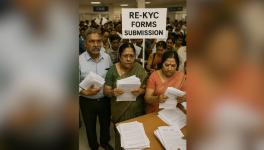GDP Estimates — Smoke And Mirrors With Economic Statistics
The season of statistical illusions is back again. The first initial estimates of national income for the first quarter of the current financial year, released on August 31, revealed that Indian gross domestic product (GDP) grew at 13.50% in April-June 2022, compared with the same quarter of the previous year. Gross value added or GVA, which is nothing but the GDP minus taxes and net of subsidies, increased by 12.7% in the first quarter on an annualised basis.
To the acolytes of the Narendra Modi government, this seemed to provide evidence, yet again, to lay claims to bragging rights that India is among the world’s fastest-growing economies. But wait, not so fast, would say the skeptics who have a slightly healthier respect for the nuances of economic statistics.
Growth, expressed in percentages is misleading, particularly in a period when the underlying statistics are in the throes of volatility, as is the case in the years of the unprecedented pandemic. This plays out as what those in the business of statistics term the “base-effect” problem. Thus, the 13.5% increase in the last quarter is slower than the pace set in the same quarter of the last year when the economy grew at 20.1%. This was but natural after the collapse of economic activity and output as a result of the pandemic.
In fact, the 13.5% growth in GDP was lower than the Reserve Bank of India’s (RBI) forecast. It had predicted that the economy would grow at 16.2% in the first quarter. This immediately brings into question the central bank’s growth projections for the full year. The RBI had forecast that the economy would grow at 7.2% in 2022-23; the latest GDP numbers now show that this projection is likely to be missed, implying that growth is likely to be sub-7% in the full year.
As has been repeatedly pointed out here and elsewhere, the fixation with growth rates expressed in percentages blinds us to the true extent of a “recovery”, especially because it misses the specific context of the collapse in economic output as a result of the pandemic. In fact, the economic deceleration predates the pandemic, if only media pundits would care to visit the very same official statistics that are now being cited as evidence that a recovery is underway.
The data in historical context
First, let us set the latest data in some historical context, even during the Modi regime’s own tenure since 2014. Between the first quarter of 2014-15 (when Modi first assumed office) and the first quarter of 2018-19 (mind you, well before the pandemic), Indian GDP grew at an average rate of 7.58% per annum. In comparison, the average annual growth rate of GDP fell by more than half this rate — 3.68% per annum — between the first quarters of 2019-20 and 2022-23. The latest quarterly numbers have to be situated in this context, of an economy that is not just slowing but is now additionally buffeted by inflationary pressures.
Second, for the reasons mentioned earlier, about the problems associated with percentages and the ‘base effect problem’, it would be more illuminating to look at the levels of actual of output and then use those as a benchmark to evaluate the claims of a recovery.
According to the data released on Wednesday, GVA in the first quarter of the current fiscal year was estimated at Rs. 34.42 lakh crore; GDP in the same period was Rs. 36.85 lakh crore. These figures imply that GVA increased by 12.7% over the previous year and that GDP increased by 13.5% on an annualised basis in the first quarter.
But the apparently rosy picture fades quickly when logic and context are taken into account. It turns out that GVA expressed in real terms (constant prices) in the first quarter of the current year was just 4.65% more than the level prevailing in the same quarter three years earlier, well before the worst of the pandemic hit India. To put this in perspective, this implies that GVA in the Indian economy has grown at a princely rate of 1.55% per annum over a three-year period.
A similar exercise with reference to GDP statistics shows the Modi regime in even poorer light. The overall increase was just 3.8 %; in annualised terms the economy has barely moved, an increase of just about 1.28% per annum. To term this as evidence of recovery is laughable, even if the matter is far more serious involving the fate of the livelihoods of millions.
The collapse of consumption and investment
Much noise is being been made about the how consumption levels are again on the rise. Here again, the noise is devoid of any respect for facts, context or logic. It is true that the share of Private Final Consumption Expenditure (PFCE) in GDP — which normally accounts for about half of all GDP — increased to 59.9% in the first quarter. A year earlier, the share of PFCE was just 54%. But this is no cause for celebration. As is well known, PFCE collapsed in the pandemic and its recovery has been in fits and starts. A little bit of historical context would be a good antidote to the euphoria that has welcomed these numbers.
In the first quarter of the current year, PFCE amounted to Rs. 22.08 lakh crore, compared with Rs 20.09 lakh crore in the same quarter of 2019-20. This implies an annual rate of increase of 3.30%. Now let us put this in context. In the three years before the pandemic, between 2017-18 and 2019-20, when the economy was already slowing down, PFCE increased at an annual rate of 7.37% per annum. Only an utter bhakt would celebrate the halving of consumption in the national economy!
What these figures indicate is that the consumption-led motor running the national economy has just not been firing. Of course, this sits well with the fact that the Modi regime, unlike most others across the world, steadfastly refused to provide a stimulus to the economy that would support lost livelihoods and incomes, which is a prerequisite for a consumption-led recovery.
To compound matters, Government Final Consumption Expenditure, which has the potential to prop sagging demand, also registered tepid growth in the first quarter. In fact, in absolute terms, it was lower than levels reached two years earlier.
Optimists in the government, as well as its acolytes outside, have gleefully pointed to the 20% increase in Gross Fixed Capital Formation (GFCF) as evidence that private investment is picking up, finally. Here, too, euphoria blinds a reference to context and a respect for statistical nuance and plain common sense. The fact of the matter is that GFCF amounted to Rs. 12.78 lakh crore in the first quarter of 2022-23, which was just 6.77% more than the GFCF three years earlier.
After the collapse of investment during the pandemic, it is likely that much of the “fresh” investment is primarily the possible resumption of industrial investments that were put on hold in the last three years. The raging inflationary pressures, coupled with lacklustre performance on the consumption front — government as well as private — are likely to hold back fresh investments. Moreover, the uncertainty on the interest rate front is likely to deter industrial investments.
Economic activity slackens
The analysis of the sectoral break-up of the economic performance presents a gloomier picture. Three key sectors — manufacturing, construction and trade (which includes hotels, transport and communications) — all of which employ a significant proportion of the workforce and are key sources of employment, continue to fare poorly. These three sectors of economic activity, which accounted for 41% of overall GVA, continue to remain mired in the throes of a slowdown.
The GVA emanating in manufacturing amounted to Rs. 6.05 lakh crore in the first quarter of the current year, an increase of a measly 4.8% over the previous year. But even this provides a charitable view of the actual state of affairs; the reality is that GVA in manufacturing has increased at the rate of just 2.3% per annum in the last three years.
The GVA emanating from trade and related services, which is the main source of employment (and which is also a refuge for millions in disguised unemployment) and which is important for livelihoods even if wages are low and terms of employment insecure, has been among the worst performing sectors. The GVA emanating from this sector in the first quarter of 2022-23 was Rs. 5.6 lakh crore, which, shockingly, was actually lower than the GVA registered by this sector three years earlier. In fact, GVA in this sector was 15.41% lower in 2022-23 than in 2019-20.
Economic activity in construction, which has been a primary source of employment in rural as well as urban areas in the last decade, and which is a major source of employment for migrant workers from the backward regions of the country, has been practically at a standstill when placed in historical context. The GVA emanating from this sector amounted to Rs. 2.63 lakh crore in the first quarter of the current year, having barely moved from the level it was at — Rs. 2.60 lakh crore — in 2019-20.
Meanwhile, while exports as a proportion of overall GDP have remained stagnant, the share of imports surged in the last year. Imports, which accounted for 25.7% of GDP in the first quarter of the previous year, surged to 31% in the first quarter of 2022-23. This confirms that the problems arising from the slowdown of the economy are compounded by the mounting pressures on the balance of payments and foreign exchange fronts, which further constrains the policy choices of the Modi regime.
The Modi government’s rapidly diminishing degrees of freedom are, of course of its own making. Having steadfastly refused to countenance any kind of policies that, on the one hand, promote public spending that generates economic activity and incomes, and, on the other, mobilise resources from the well-heeled, who have seen their incomes surge in the pandemic, it now is likely to only heap further misery on those who have suffered the most.
Get the latest reports & analysis with people's perspective on Protests, movements & deep analytical videos, discussions of the current affairs in your Telegram app. Subscribe to NewsClick's Telegram channel & get Real-Time updates on stories, as they get published on our website.
























